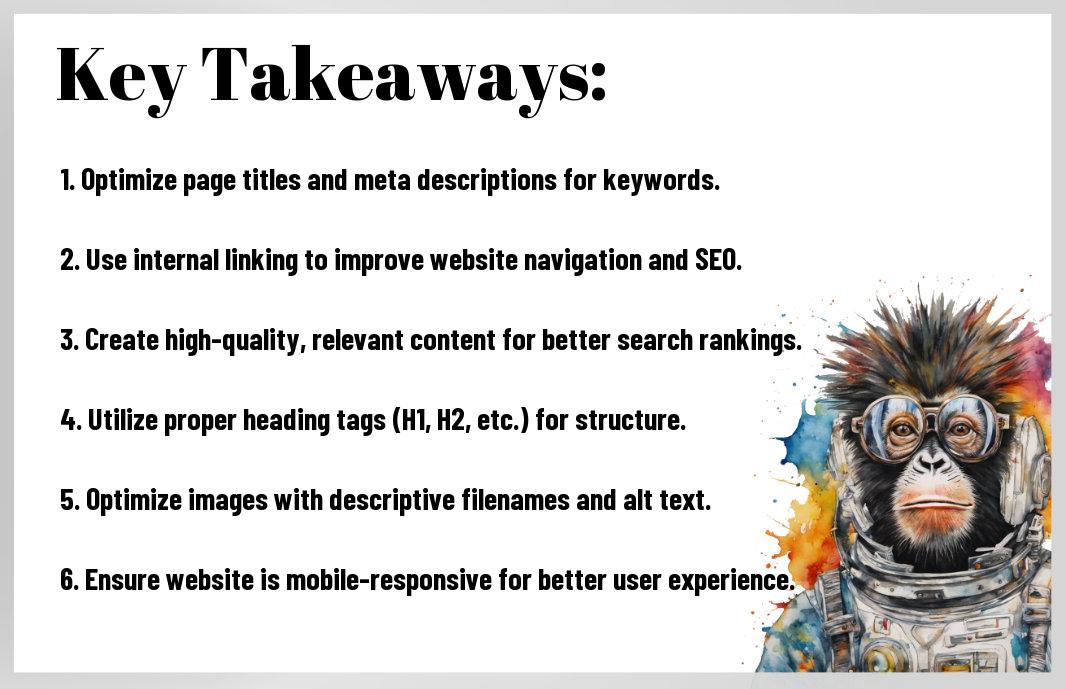With the ever-evolving landscape of digital marketing, it is crucial for websites to stay ahead by implementing effective on-page SEO techniques. These strategies not only improve search engine rankings but also enhance user experience, leading to increased organic traffic and higher conversion rates. In this article, we will explore into the top 5 on-page SEO techniques that every website should incorporate to ensure visibility, credibility, and success in the competitive online world.
Key Takeaways:
- Optimize Keywords: Utilize relevant keywords in titles, meta descriptions, headings, and throughout the content to improve search engine ranking.
- Quality Content: Create high-quality, engaging content that is valuable to your target audience to increase user engagement and attract organic traffic.
- Internal Linking: Implement internal links to connect related content within your website, improving navigation and increasing the visibility of important pages to search engines.


Keyword Optimization
Identifying Target Keywords
It is crucial to start your keyword optimization process by identifying the right target keywords for your website. These are the terms or phrases that your target audience is searching for on search engines. To do this effectively, you can use keyword research tools like Google Keyword Planner, SEMrush, or Ahrefs to find relevant keywords with high search volume and low competition.
Strategic Keyword Placement
Target keywords should be strategically placed throughout your website’s content to signal search engines about the relevance of your pages. Ensure to include target keywords in your page titles, meta descriptions, headers, and within the body content naturally. Overusing keywords, known as keyword stuffing, can have negative repercussions on your website’s SEO ranking, so it’s crucial to strike a balance.
Content Quality and Relevance
Creating Valuable and Informative Content
Once again, one of the most crucial aspects of on-page SEO is the quality and relevance of your content. Content that is valuable and informative not only engages your readers but also helps search engines understand the purpose and relevance of your website.
Ensuring Content Freshness and Update Frequency
Once again, keeping your content fresh and regularly updated is vital for maintaining a strong online presence. Search engines prefer websites that consistently provide new and relevant content to users. By updating your content frequently, you can improve your website’s SEO performance.
Freshness: Regularly updating your content signals to search engines that your website is active and relevant. This can lead to higher rankings in search results, increased organic traffic, and better user engagement. On the other hand, outdated content can harm your SEO efforts and cause your website to drop in rankings.
Meta Tags and Descriptions
All SEO practitioners understand the importance of meta tags and descriptions in optimizing website content for search engines. Meta tags provide crucial information about a webpage’s content to search engines, influencing its ranking in search results. According to The Ultimate Guide to On-Page SEO in 2023, crafting compelling meta titles and writing effective meta descriptions are vital for enhancing on-page SEO performance.
Crafting Compelling Meta Titles
Meta titles are critical elements that appear as clickable links in search engine results. They should be relevant, keyword-rich, and enticing to attract clicks from users. Make sure to keep them within 55-60 characters to ensure they display correctly in search results.
Writing Effective Meta Descriptions
Meta descriptions are brief summaries that appear below the meta titles in search results. They should be compelling, concise, and relevant to encourage users to click through to your website. Aim for 150-160 characters to ensure they are fully displayed in search results. Incorporating targeted keywords can also help improve search visibility.
Titles and descriptions play a crucial role in attracting organic traffic to your website. By optimizing these elements with relevant keywords and engaging copy, you can enhance your website’s visibility in search results and drive more clicks from potential visitors.
URL Structure and Navigation
Simplifying URL Structures
The URL structure of a website plays a crucial role in helping search engines understand the content and hierarchy of your site. Keeping URLs simple, descriptive, and user-friendly can have a significant impact on your site’s SEO performance. Avoid long strings of numbers or irrelevant characters in your URLs. Include keywords that accurately describe the content on that page, making it easier for both search engines and users to navigate your site.
Improving Website Navigation and User Experience
Improving website navigation and user experience is crucial for retaining visitors and encouraging them to explore more of your site. A clear and intuitive navigation menu can help users easily find what they are looking for, reducing bounce rates and increasing engagement. Consider organizing your content into categories and subcategories, making it easier for visitors to navigate through your site seamlessly.
Simplifying the navigation structure by including breadcrumbs, internal links, and a search function can further enhance user experience and encourage visitors to spend more time on your site. Ensure that your website loads quickly and is mobile-responsive to provide a seamless browsing experience across all devices.
Mobile-Friendly Website Design
Importance of Responsive Design
Nowadays, with the increasing number of people accessing websites through their smartphones and tablets, having a responsive design is crucial for any website. Designing your website to be mobile-friendly ensures that all users, regardless of the device they are using, have a seamless and visually appealing experience. This not only improves user satisfaction but also helps in reducing bounce rates and increasing user engagement.
Impact on Search Engine Rankings
Now, let’s talk about the impact of having a mobile-friendly website design on your search engine rankings. Search engines like Google prioritize websites that are mobile-friendly in their search results. Websites that are not optimized for mobile devices may see a significant drop in their rankings. This means that having a responsive design is not just beneficial for user experience but also crucial for improving your visibility and ranking on search engine results pages.
Another crucial point to consider is that search engines now use mobile-first indexing, meaning they prioritize the mobile version of a website for indexing and ranking. This makes it imperative for websites to have a responsive design to ensure they are not penalized in search rankings.
Image Optimization
Using Alt Text and Image Titles
Your website’s images play a crucial role in enhancing user experience and improving SEO. We recommend using alt text and image titles to provide context to search engines about the content of the image. Alt text should be descriptive and include relevant keywords to help search engines understand the image’s significance.
Compressing Images for Faster Load Times
For optimal website performance, it’s crucial to compress images to ensure faster load times. Large image files can slow down your site, leading to a poor user experience and potentially lower search engine rankings. Compressing images reduces file size without compromising quality, making your website load faster and improving overall site speed.
Image compression is crucial for mobile users who may have slower internet connections. By optimizing images for speed, you can provide a seamless browsing experience across all devices, ultimately leading to improved SEO performance.
Internal Linking Strategy
Strengthening Site Architecture
Unlike external linking strategies that focus on connecting different websites, internal linking is all about connecting pages within your own website. The primary goal of internal linking is to enhance site architecture, making it easier for users to navigate and improving the overall user experience. By strategically linking related pages together, you can guide visitors to explore more content on your site, increasing engagement and reducing bounce rates.
Enhancing Content Discoverability
Strategy The key to enhancing content discoverability through internal linking lies in understanding the relevance and context of your pages. By strategically placing internal links within your content, you can direct users to related articles or products, increasing the chances of them discovering valuable information. This not only improves the user experience but also helps search engines crawl and index your site more effectively, boosting your SEO performance.
Strengthening the internal linking structure of your website can have a significant impact on your SEO efforts. By creating a logical hierarchy and establishing relevant connections between pages, you can improve the overall user experience and make it easier for search engines to understand the context of your content. Remember to use descriptive anchor text and avoid overloading pages with too many links, as this could dilute the effectiveness of your internal linking strategy.
Page Load Speed
Many website owners underestimate the importance of page load speed in their SEO strategy. A slow-loading website can not only frustrate visitors but also have a negative impact on your search engine rankings. Implementing 15 On-Page SEO Techniques (Basic and Advanced) can significantly improve your website’s performance and user experience.
Tools for Measuring Page Speed
One important tool for measuring page speed is Google’s PageSpeed Insights. This tool provides valuable information on your website’s performance and offers suggestions for improvement. Other popular tools include GTmetrix, Pingdom, and WebPageTest.
Techniques for Improving Load Times
To enhance your website’s load speed, consider optimizing images, minifying CSS and JavaScript files, leveraging browser caching, and utilizing a content delivery network (CDN). These techniques can help reduce server response time and enhance user experience on your site.
Load optimizing images involves resizing images to the appropriate dimensions and using the correct file format (JPEG, PNG, etc.) to ensure faster loading times. Minifying CSS and JavaScript files involves removing unnecessary code and whitespace to reduce file size. Leveraging browser caching allows returning visitors to load your site more quickly by storing cached versions of your pages. Finally, using a content delivery network (CDN) can help deliver resources from servers closer to the user, reducing load times. By implementing these techniques, you can significantly improve your website’s page load speed and enhance your SEO efforts.
Final Words
Drawing together the top 5 on-page SEO techniques every website should implement, it is clear that optimizing your website for search engines is important for driving organic traffic and increasing visibility online. By focusing on creating high-quality content, enhancing user experience, optimizing meta tags, improving website speed, and using internal links effectively, your website can climb the search engine rankings and attract more visitors. Implementing these SEO techniques requires dedication and ongoing effort, but the results are well worth it in the end. So, make sure to prioritize on-page SEO for your website to stay ahead of the competition and reach your target audience effectively.
FAQ
Q: What are the top 5 On-Page SEO techniques every website should implement?
A: The top 5 On-Page SEO techniques that every website should implement are: 1. Optimizing meta tags (title, description, headers), 2. Creating high-quality and relevant content, 3. Improving website loading speed, 4. Using keyword optimization effectively, and 5. Optimizing internal linking structure. By incorporating these techniques, you can boost your website’s search engine rankings and attract more organic traffic.
Q: How important is optimizing meta tags for SEO?
A: Optimizing meta tags, including title tags, meta descriptions, and header tags, is crucial for SEO success. These tags provide search engines with information about your website’s content and help improve your website’s visibility in search results. By optimizing meta tags with relevant keywords and compelling descriptions, you can enhance your click-through rate and drive more traffic to your site.
Q: Why is creating high-quality content imperative for On-Page SEO?
A: Creating high-quality and relevant content is imperative for On-Page SEO because it not only helps your website rank higher in search results but also engages and retains visitors. Search engines prioritize websites that offer valuable and informative content to users. By creating content that is both SEO-friendly and user-friendly, you can establish your website as a reliable source of information and improve your overall SEO performance.
